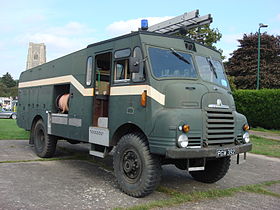The Green Goddess is the colloquial name for the Bedford RLHZ Self Propelled Pump, a fire engine used originally by the Auxiliary Fire Service (AFS), and latterly held in reserve by the Home Office until 2004, and available when required to deal with exceptional events, including being operated by the British Armed Forces during fire-fighters’ strikes (1977 and 2002). These green-painted vehicles were built between 1953 and 1956 for the AFS. The design was based on a Bedford RL series British military truck.
Auxiliary Fire Service
The Auxiliary Fire Service was established as part of civil defence preparations after World War II, and subsequent events such as the Soviet Union detonating an atomic bomb made their presence supporting civilians as part of Britain's civil defence an important role. It was thought that a nuclear attack on Britain would cause a large number of fires, which would overwhelm the ordinary fire service, so a large stock of basic fire engines was ordered to form a reserve capacity. They were in continuous use by the AFS, until disbandment in 1968 by the Harold Wilson Government.
The Green Goddess machines were not primarily fire engines (AFS members referred to them as 'appliances'); they are more correctly titled "self propelled pumps", with some being two-wheel drive (4x2), and others in four-wheel drive (4x4) form. Their main role was to pump huge quantities of water from lakes, rivers, canals and other sources into cities hit by a nuclear attack. The machines could be used in a relay system over a number of miles, with Green Goddesses at regular intervals to boost the water pressure. Firefighting was a secondary role.
Operational use
Prior to disbandment, the AFS used the Green Goddess extensively in support of the local fire services throughout the UK. They provided additional water delivery and firefighting capability at times when the regular fire brigades had a major incident to contain. The ability to relay large quantities of water over considerable distances was invaluable in some more remote locations, or where the incident required more water than local water systems could provide. Most UK boroughs had an Auxiliary Fire Service detachment housed alongside the regular brigade equipment.
After 1968, the vehicles were mothballed, but occasionally used by the Armed Forces to provide fire cover in a number of fire strikes, notably in 1977 and 2002 (see UK firefighter dispute 2002–2003). They were also deployed to pump water in floods and droughts. They were well maintained in storage, and regularly road tested. There was a less significant strike by firefighters in the Winter of Discontent (late 1978 and early 1979), where once again the Green Goddesses were drafted in to cover; it is largely forgotten by many as it occurred at a time when a significant percentage of public sector workers were on strike.[1]
The role of Green Goddesses was superseded by new contingency arrangements. The Fire and Rescue Services Act 2004 gave the Government the power to instruct fire and rescue authorities to make their own vehicles available in the event of future industrial action. New Incident Response Units introduced after the September 11, 2001 attacks offered high power pumping ability among a range of other contingency functions.






